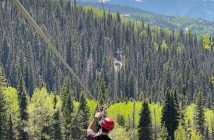This is an exciting time in the world of zip lines and adventure parks. The industry has been evolving for 20 years around the world. In North America, high-angle activities are sprouting at zoos and museums, among other institutions, and are becoming a key element in the summer operations of many winter resorts. As a result, we are just now entering a stage of heightened scrutiny and, ultimately, regulation. And that could change the way zip lines, and especially braking systems, operate.
“In today’s aerial adventure industry, more and more high speed and longer zip lines are coming into use. Participants like the adventure of traveling at higher speeds on the line,” says Mike Holder, owner/operator and founder of American Adventure Park Systems, which builds zip lines and parks, and operates Historic Bannings Mills, Ga., among other courses.
“Zip line and canopy tour builders are finding increasing requests for such lines, but many of the courses’ terrain may not provide the necessary gravity braking to slow participants to the six miles per hour needed to land. Hence the need for braking systems which allow for these type lines and give a wider safety margin,” he notes.
“There is no mystery as to why braking systems and safety have dominated the industry conversations in the last few years,” adds Shawn Lerner, founder and CEO of Zip-Flyer LLC. “It’s widely known the root cause of most zip line accidents is operator error. In many parks, the guides are still responsible for braking participants safely. While most guides are well trained and take their work very seriously, the future of these parks and industry regulation is in the hands of every guide on a daily basis. That said, owners and operators want braking systems that not only work every time, but take the braking out of the hands of their staff.”
BRAKING SYSTEMS

Aerial Designs is a traditional passive brake block controlled zip line braking system. The ZipSTOP from Head Rush Technologies offers magnetic passive braking and automatic resetting of the brake

Zip-Flyer and Head Rush Technologies have partnered to create the hybrid zipSTOP and have incorporated the technology into Zip-Flyer’s ZF Track Braking System, capable of stopping a 300-pound rider at speeds up to 140mph. The Zip-Trolley System from Zip-Flyer is a simpler version of the ZF System and is designed specifically for the masses.
Let’s take a look at these systems that play a key role in keeping customers safe and coming back.
The oldest, simplest, and least expensive braking systems are “active braking systems,” whereby the rider applies pressure to the cable to brake, typically with the hand reinforced by a leather glove. Active systems are easier and cheaper to set up, and can also be a lot of fun. But they require a higher level of rider skill land engagement, and with that, may involve a higher level of risk as well.
Many successful operators still use active systems. Years of experience in the challenge course industry have taught thousands of guides and customers to become comfortable with active braking—hand braking or, when ground landing, physical foot braking in a “striding arrival.” But in the pay-to-play world of adventure parks and commercial zip lines, more customers each season will likely be unfamiliar and uncomfortable with active braking.
In the commercial market, “passive braking systems” are becoming the new norm, whereby a line operator, technology or gravity, not the rider, controls the brake. These systems may be applicable to a broader range of users, including children.
Such systems are not new, of course. Even many active braking lines use automatic braking, such as a braking block, as a backup to hand or foot braking. So, while active braking makes sense in some cases, for many zip lines, passive braking is the future, and has been the focus of intense international development in recent years.






